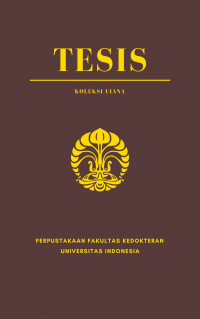Tesis
Profil Photoaging berdasarkan Dermoscopy Photoaging Scale pada Populasi Daerah Pesisir dan Berbagai Faktor yang Berhubungan = Photoaging Profile Based on Dermoscopy Photoaging Scale in the Coastal Populations and Influencing Factors Involved.
Latar belakang: Photoaging merupakan penuaan kulit yang disebabkan oleh radiasi UV. Belum ada baku emas untuk mengidentifikasi photoaging. Seiring berkembangnya teknologi kedokteran terdapat penelitian yang membuat dermoscopy photoaging scale (DPAS) sebagai skala pemeriksaan noninvasif untuk mendiagnosis photoaging. Individu yang secara geografis tinggal di daerah yang sering terpajan sinar matahari lebih rentan mengalami photoaging, contohnya daerah pesisir. Pengukuran pajanan sinar matahari menggunakan kuesioner dapat dilakukan menggunakan sun index. Terdapat berbagai faktor yang memengaruhi photoaging di antaranya usia, jenis kelamin, tipe kulit, dan rokok. Tujuan: Mengetahui profil photoaging dan membuktikan hubungan sun index dengan gambaran photoaging berdasarkan DPAS pada populasi daerah pesisir. Metode: Penelitian ini merupakan suatu penelitian observasional dengan desain potonglintang. Pada penelitian ini dilakukan anamnesis untuk menilai sun index, pemeriksaan fisis, dan pemeriksaan dermoskopi untuk menilai DPAS. Profil photoaging berdasarkan DPAS, usia, jenis kelamin, tipe kulit, dan rokok disajikan sesuai proporsi. Uji korelasi Spearman digunakan untuk menilai korelasi sun index dengan DPAS. Hasil: Sejumlah 100 individu usia >18 tahun yang tinggal di Kecamatan Cilincing, Jakarta Utara menjadi subjek penelitian. Median skor DPAS adalah 9 (1–21) dan median skor DPAS tertinggi didapatkan pada regio pipi kanan sebesar 3 (0–6) dan kiri, yaitu 3 (0–7). Median skor DPAS pada laki-laki adalah 9, lebih besar dibandingkan pada perempuan, yaitu 8. Terdapat peningkatan rerata DPAS seiring peningkatan usia dengan rerata total skor DPAS tertinggi pada kelompok usia ≥ 60 tahun, yaitu 16. Terdapat hubungan bermakna skor DPAS dengan usia (p < 0,001). Rerata total skor DPAS tertinggi didapatkan pada kelompok perokok aktif, yaitu 11 dan kelompok kulit Fitzpatrick tipe IV, yaitu 10. Tidak terdapat hubungan antara skor DPAS dengan sun index (p=0,957). Kesimpulan: Skor DPAS tidak berkorelasi dengan sun index diduga karena skor DPAS hanya menilai regio wajah, sedangkan sun index memperhitungkan BSA seluruh tubuh yang terpajan sinar matahari. Namun terdapat hubungan bermakna skor DPAS dengan usia, semakin tinggi usia maka skor DPAS juga semakin tinggi.
Kata kunci: dermoskopi photoaging scale, sun index, faktor yang memengaruhi
Background: Repeated exposure to ultraviolet light are the most significant factors that contribute to photoaging. There is no gold standard for identifying photoaging. dermoscopy photoaging scale (DPAS) recently developed as a noninvasive examination scale to diagnose photoaging. Individuals who geographically live in areas that are often exposed to sunlight, for example coastal areas, are more susceptible to photoaging. Measurement of sunlight exposure using questionnaire can be done using sun index. In addition, there are other factors that affect photoaging such as genetics, age, sex, skin type, and cigarettes. Objective: To study dermoscopic features of photoaging and to relate these features with sun index in the coastal population. Methods: This is a descriptive cross-sectional study. History taking was performed to assess sun index; physical examination and dermoscopy to determine DPAS. Photoaging profiles were reported in proportion namely DPAS, age, gender, skin type, and smoking. The Spearman correlation test was used to assess the relationship between sun index and DPAS. Results: A total number of 100 subjects who lived in Cilincing, North Jakarta included in this study and scored a median DPAS of 9 (1–21). Regarding facial anatomic regions, the highest median for DPAS was right and left cheek, 3 (0–6) and 3 (0–7) consecutively. Men have a higher median DPAS score of 9 than women, who have a score of 8. There was a significant difference between DPAS score and age (p < 0,001). The average DPAS increased with age, with the 60-year-olds having the greatest average total DPAS score of 16, which is the highest of all age groups. The active smokers group with DPAS score of 11 and skin phototype IV had the highest mean total DPAS score. Sun index are not correlated with DPAS score (p=0,957). Conclusion: DPAS score are not correlated with the sun index allegedly because DPAS only evaluate face area, whereas sun index is determined based on the complete body surface area (BSA). However, there was a significant relationship between DPAS and age, the older the subjects are, the higher the DPAS score.
Keywords: dermoscopy photoaging scale, sun index, influencing factors
- Judul Seri
-
-
- Tahun Terbit
-
2021
- Pengarang
-
Riris Asti Respati - Nama Orang
Shannaz Nadia Yusharyahya - Nama Orang
Siti Rizny F. Saldi - Nama Orang
Larisa Paramitha - Nama Orang - No. Panggil
-
T21211fk
- Penerbit
- Jakarta : Program Pendidikan Dokter Spesialis Dermatologi dan Venerologi., 2021
- Deskripsi Fisik
-
xviii, 127 hal; ill; 21 x 30 cm
- Bahasa
-
Indonesia
- ISBN/ISSN
-
-
- Klasifikasi
-
NONE
- Edisi
-
-
- Subjek
- Info Detail Spesifik
-
Tanpa Hardcopy
| T21211fk | T21211fk | Perpustakaan FKUI | Tersedia |


Masuk ke area anggota untuk memberikan review tentang koleksi